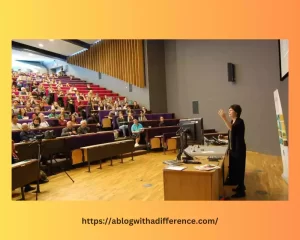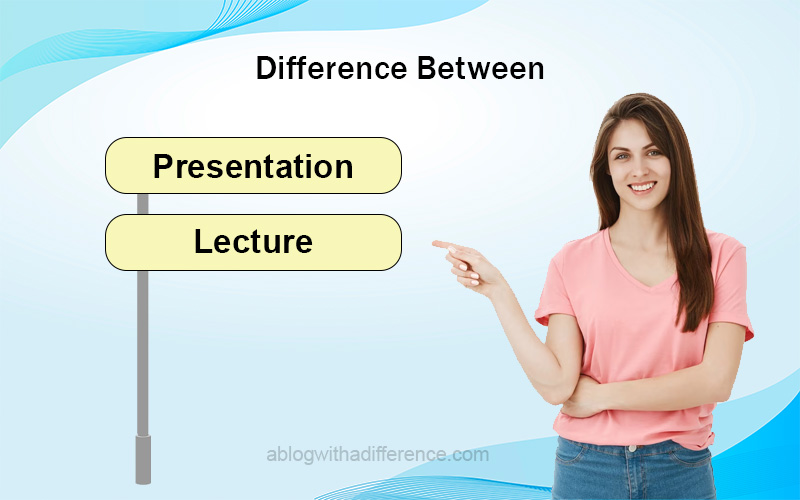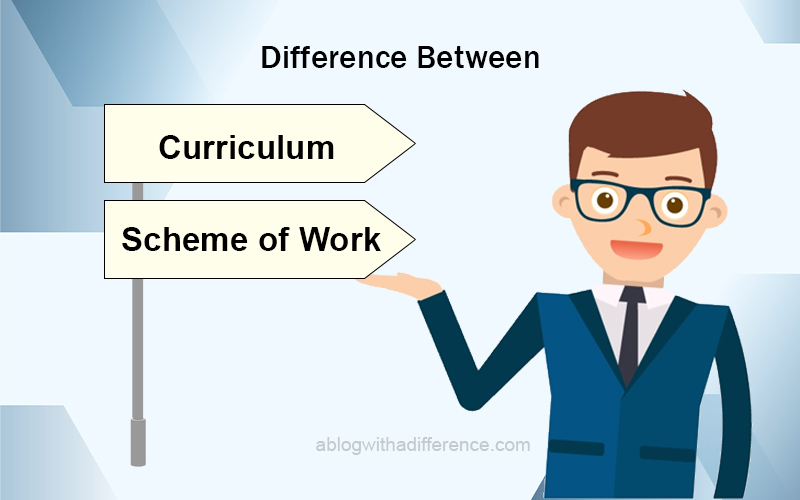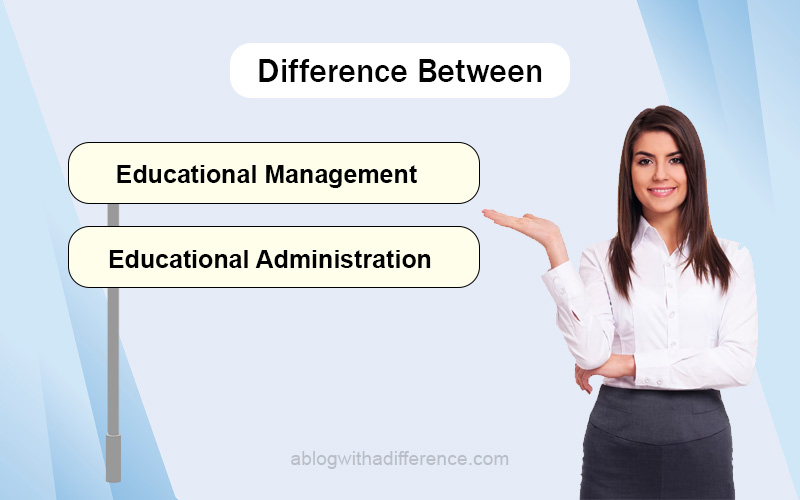Difference Between Presentation and Lecture
Definition of Presentation and Lecture
Presentation: Presentation is a form of communication in which information, ideas and concepts are disseminated to an audience through visual or verbal means. A presentation typically follows an organized structure while often including visual aids like slideshows or multimedia elements to augment content delivery to an audience.
Presentations are used across educational, business and professional environments to share knowledge, persuade viewers, educate or entertain audiences. Presentations may take the form of live talks, online webinars, workshops conferences or training sessions – these options all enable presenters to connect their message effectively with audiences.

Presentations serve to effectively communicate their intended message to audiences while captivating and informing them in an accessible fashion. Presenters commonly utilize storytelling, examples and visual aids in order to deepen audience understanding of content presented and increase retention rates of its message. Effective presentations typically involve careful planning, research, organization of ideas and consideration of their target audience.
Presenters strive to engage their audience, keep their interest up and ensure the message gets across clearly. Audience participation may be encouraged through activities, questions or discussions in order to promote interaction and foster an environment conducive for collaborative learning or sharing environments.
Lecture: Lectures are formalized modes of instruction or presentation where an authority on a certain field gives a spoken discourse to an audience, intended to impart knowledge, explain concepts or provide insights regarding a topic of particular importance. Lectures are commonly employed within academic settings like universities, colleges and schools where professors or instructors deliver them directly to students. But lectures can also be given outside academic environments such as conferences, seminars, public talks or professional development programs.
Lectures serve a fundamental function: they transfer knowledge and ideas between speakers and audiences. Lectures typically entail one-way communication: with speakers giving their content verbally while listeners listen and take notes; sometimes the lecture may include explanations, theories, research findings, case studies, historical analyses or examination of a subject matter.
Lectures often follow a structured format, with speakers organizing their thoughts and presenting information logically in order. Visual aids may be utilized during lectures; however, spoken communication remains primary as visuals rarely play an essential part. Length can vary based on topic – anything from an extended session of several hours can occur!

Audience participation during lectures tends to be minimal compared to presentations; however, certain lectures may allow for questions and dialogue at certain points or near the conclusion of each session. Interacting with your audience is vitally important; interaction can clarify ideas further while developing critical thinking abilities.Lectures serve to disseminate information, impart expertise, and facilitate learning by offering an authoritative explanation on a particular subject matter.
Differences between Presentation and Lecture
There are several key differences between Presentation and Lecture:
- Communication Style:
- Presentation: Presentations typically involve interactive and engaging communication styles. Presenters often encourage audience participation, ask questions, and facilitate discussions.
- Lecture: Lectures primarily follow a one-way communication style, where the speaker delivers information, and the audience listens and takes notes. The focus is on the speaker’s expertise and conveying information rather than interactive dialogue.
- Audience Involvement:
- Presentation: Presentations aim to actively involve the audience. They often include activities, group discussions, audience responses, and opportunities for questions and answers.
- Lecture: Audience involvement in lectures is usually limited. While some lectures may allow for questions or discussions, the emphasis is primarily on the speaker delivering information, and the audience’s role is to listen and absorb the content.
- Delivery Method:
- Presentation: Presentations make use of various visual aids, such as slides, charts, videos, or multimedia elements, to support and enhance the delivery of information. Demonstrations or live examples may also be incorporated.
- Lecture: Lectures primarily rely on verbal delivery. While visual aids can be used, such as slides or diagrams, the main focus is on the speaker’s spoken words and explanations.
- Time Allocation:
- Presentation: Presentations tend to be shorter in duration, typically ranging from a few minutes to an hour. They focus on delivering key information concisely and engaging the audience within a limited timeframe.
- Lecture: Lectures are often longer in duration, ranging from an hour to multiple hours. They allow for a more extensive exploration of a subject, in-depth explanations, and the presentation of complex concepts.
While there are these differences, it is important to note that Presentation and Lecture also share some similarities. Both aim to disseminate information, require subject matter expertise from the presenter/lecturer, and involve careful preparation and organization of content. The choice between a presentation or lecture depends on factors such as the goals of the session, the desired level of audience involvement, and the nature of the subject being presented.
Comparison chart
| Aspect | Presentations | Lectures |
|---|---|---|
| Communication Style | Interactive and engaging | One-way communication |
| Audience Involvement | Encourages participation and interaction | Limited audience participation, mainly listening |
| Delivery Method | Visual aids, multimedia, demonstrations | Primarily verbal delivery |
| Time Allocation | Typically shorter in duration | Usually longer in duration |
| Focus | Conveying information, persuasion, education, entertainment | Imparting knowledge, explaining concepts |
| Interactivity | Emphasizes audience participation, discussions, activities | Limited audience interaction |
| Visual Aids | Reliance on visual aids, multimedia elements | Visual aids may be used, but the emphasis is on verbal delivery |
| Learning Environment | Engages and stimulates audience involvement | Emphasizes listening and note-taking |
| Goal | Engaging and conveying information concisely | Delivering comprehensive information and complex concepts |
| Flexibility | Allows for various presentation formats (slideshows, multimedia) | Can adapt to different subject matters and teaching styles |
| Participation | Encourages active audience engagement and questions | Audience participation is limited, questions may be addressed at specific times |
Similarities between Presentation and Lecture
Presentations and lectures differ considerably; nonetheless they share certain commonalities as well.
Here are a few similarities:
- Information Dissemination: Both presentations and lectures serve as effective methods of providing information to an audience, serving as platforms to share knowledge, convey concepts and provide new insight on various subjects.
- Subject Matter Expertise: Both presentations and lectures require presenters or lecturers to possess extensive subject knowledge for discussion purposes, with deep insight into any given topic being covered and accurate and reliable information being delivered to their audiences.
- Prep and Organization: Both presentations and lectures require careful preparation and organization in order to be effective. Presenters or lecturers need to lay out their content logically, identify key points they’d like covered, and create an informative narrative or flow. Adequate research preparation will lead to successful presentations or lectures.
- Audience Engagement: While presentations and lectures differ significantly in their levels of audience involvement, both formats strive to engage their target audiences effectively. Presenters and lecturers aim to capture attention, maintain interest, ensure understanding and retention. Employing visual aids, storytelling techniques or engaging speaking styles may enhance audience engagement for either format.
- Learning and Knowledge Transfer: Presentations and lectures serve as platforms for education and knowledge transfer, offering audiences opportunities to acquire new information, deepen their understanding of a subject area or gain from presenter expertise. Both formats contribute towards educational processes as they may promote critical thinking skills as well as intellectual growth.
Presentations and lectures both aim to effectively share information and facilitate learning among their audiences, with presentations typically employing interactive approaches while lectures tend to rely more heavily on text-heavy approaches for audience participation. Determining whether to utilize presentations or lectures often depends on specific circumstances and goals as well as desired levels of involvement by audiences.
Length of time
Presentation and Lecture times vary significantly based on various considerations such as topic nature, level of detail needed and context; presenter preferences as well as audience size are among these variables.
Following are a few general tips:
Presentations:
- Presentations usually last anywhere between five minutes to an hour in duration.
- Shorter presentations such as lightning talks or elevator pitches typically run 5-10 minutes long while longer ones, like conference presentations or training sessions can go for 30-60 minutes at least.
- Timing for presentations typically depends upon an event’s or program schedule as well as how many presenters share one platform.
Lectures :
- Lectures can range in duration from an hour or more.
- Typically in academic settings these lessons last between 50 minutes and an hour and follow standard class periods.
- Guest lectures at conferences typically span 60-90 minutes in total duration.
- Extended lectures such as seminars or workshops often last multiple hours over multiple sessions, offering valuable education.
Setting an effective presentation or lecture requires finding an optimal balance between sufficient time to cover content effectively and keeping audiences interested and attentive. Consider complexity of topic, level of detail required and how well presenter or speaker is at maintaining audience interest when selecting presentation length or lecture duration.
Subject Depth Presentation and Lecture
Depth of coverage in presentations and lectures may depend on their goals, context, and time available.
Here are a few things to keep in mind when designing subject depth for these forms of media:
Presentations:
- Presentations provide an enlightening overview or focus on particular aspects of a subject matter.
- They aim to convey key details, main points or essential takeaways from their presentation.
- Presentations generally cover topics at a high-level, providing an overview rather than providing extensive details.
- Depending on available time, presentations may explore specific subtopics or case studies in more depth.
- Focusing on conveying information efficiently and engaging the audience through clear and precise content are top priorities.
Lectures:
- Lectures offer greater subject depth due to their longer duration.
- Lectures can delve more deeply into topics, providing a more in-depth knowledge of them.
- Theories, concepts, historical perspectives, research findings or complex analyses could all be explored during an oral defense.
- Lectures allow for in-depth exploration of subtopics, providing an extensive view of the subject matter.
- Dependent upon available time, lectures can provide multiple layers of information on a subject matter for an in-depth investigation of said topic.
Both presentations and lectures can be tailored to match any level of subject depth desired, with presentations tending towards being focused and succinct while lectures typically allow more in-depth examination of their chosen topic. When choosing between presentations or lectures as the medium for this exploration it is essential that goals, audience needs, time constraints are all taken into consideration before choosing an ideal depth level for either.
Choosing the Right Approach Between Presentation and Lecture
Finding an approach, whether that be presentation or lecture, that suits best is dependent upon many variables.
Here are a few points that could help in selecting an effective format:
- Audience Needs and Preferences: Understand your audience by considering its preferences and characteristics. Will they prefer actively engaging, participating or just listening passively? Assessing learning styles, prior knowledge levels and expectations can guide decision making processes effectively.
- Learning Objectives and Goals of Your Session: Clearly articulate the specific learning objectives or goals for this session. If the main aim is to engage audiences, foster dialogue, and facilitate collaborative learning experiences, an interactive presentation format may be more suitable; alternatively if information or concepts need to be delivered comprehensively via lecture format would likely prove more suitable.
- Complexity of Content Being Explored: Consider the nature and complexity of the subject being covered when planning how best to present it. For topics which require detailed explanations or step-by-step analysis, lecture formats might provide for deeper investigation of such subjects; alternatively if content can be effectively conveyed with visual aids, demonstrations, or audience involvement then presentation formats might prove more engaging and impactful than lecture models.
- Time Constraints: Consider how much time there is available for this session before selecting its format. Presentations can focus on quickly communicating key pieces of information while lectures may permit more in-depth debate and exploration of specific subjects. When making this determination, take into account both how much material needs to be covered as well as its required level of depth; these factors will determine what works best within available resources.
- Interactive Elements: Assess your audience interaction and participation needs carefully. If engaging the audience by inviting questions or stimulating dialogue is crucial to you, an interactive presentation format involving group activities, Q&A sessions or audience polls might be more suitable than lectures; although lectures typically provide less chances for audience involvement than interactive formats due to designated question periods.
- Context and Setting: Think carefully about where and when your presentation or lecture will take place. Different settings – academic conferences, corporate training sessions or public speaking engagements – require different approaches; keep expectations and norms of this specific environment in mind so your format satisfies audience members’ demands.
At its core, choosing between Presentation and Lecture formats should depend on individual circumstances, content type and learning outcomes desired by an instructor. Sometimes combining elements from each format into an approach that better meets audience needs while meeting goals may prove more successful than going down either of the routes alone.
Conclusion
Presentations and lectures are two distinct, yet related methods of imparting information to an audience. Presentations emphasize interactivity and audience involvement while visual aids to engage and educate the viewer while lectures utilize one-way communication with speakers with expertise in verbally conveying knowledge to an audience.
Presentations and lectures vary significantly in communication style, audience participation and delivery methods; yet both seek to disseminate knowledge by drawing upon subject matter expertise for subject-matter expertise while necessitating careful preparation and organization before being delivered as lessons or knowledge transfer sessions. They each contribute significantly towards learning experiences or knowledge transfer efforts.


